Provides a broad range of antimicrobial or antibacterial activity
Reduces infection
Prevents infection
May alter metalloproteinases within wounds with select dressings
May cause staining on wound and intact skin with silver dressings
May cause stinging or sensitization
Development of resistant organisms not yet known
 |
Contraindicated in patients with sensitivity to silver
Not for use on third-degree burns
Incompatible with oil-based products such as petroleum jelly
Cleanse the wound using conventional, non-oil-based techniques, and leave the wound moist.
Apply the dressing to the wound, either side down, and secure with an appropriate secondary dressing that will maintain a moist environment.
Keep the dressing moist but not so wet that tissue maceration occurs.
Change the dressing depending on the amount of exudate present and the condition of the wound. Avoid using oil-based cleansing agents. The dressing may be worn for up to 3 days.
Remove the secondary dressing, then remove ACTICOAT Absorbent from the wound bed. Make sure the dressing is moist before removing it.
If the dressing dries and adheres to the wound, moisten or soak the dressing before removing it.
Avoid forceful removal of the dressing and disruption of the healing wound.
Remember that the dressing may cause transient discoloration.
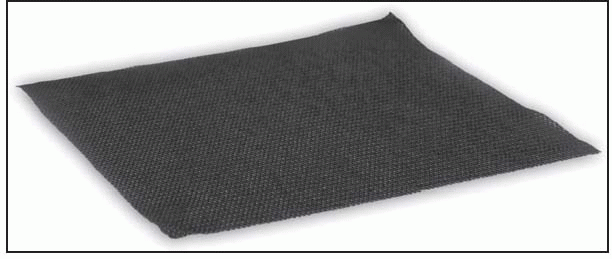 |
Flex 3 | |
Dressing: | 2″ × 2″, 4″ × 4″; A6206 |
4″ × 8″; A6207 | |
8″ × 16″, 16″ × 16″, 4″ × 48″; A6208 | |
Flex 7 | |
Dressing: | 2″ × 2″; A6206 |
4″ × 5″, 6″ × 6″; A6207 | |
8″ × 16″, 16″ × 16″; A6208 | |
1″ × 24″; A6207 | |
Not for use on patients with a known sensitivity to silver
Not for use on patients during magnetic resonance imaging (MRI) examination
Must be removed during radiation therapy; a new dressing may be applied following each treatment
Cleanse the wound using conventional, non-oil-based techniques and leave wound moist.
Remove the dressing from the package and cut to shape as necessary.
Moisten ACTICOAT Flex 3 or ACTICOAT Flex 7 Antimicrobial Dressing with sterile water or tap water. Do not use saline.
Apply the dressing to the wound surface (either side down), and secure with an appropriate secondary dressing that will maintain a moist environment.
Keep the dressing moist, but not so wet that tissue maceration occurs.
Examine the dressing to ensure a moist environment is being maintained.
Change the dressing depending on the amount of exudate and the condition of the wound.
If the dressing dries and adheres to the wound, moisten or soak the dressing prior to removal.
Avoid forceful removal and disruption of the healing wound.
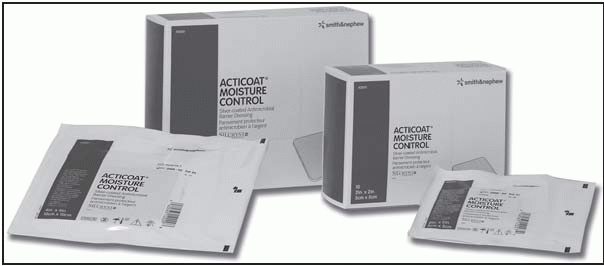 |
Not for use on patients with a sensitivity to silver
Not for use on patients during magnetic resonance imaging
For external use only
Incompatible with oil-based products, such as petroleum jelly
May not be compatible with topical antimicrobials
Incompatible with oxidizing agents (e.g., Eusol) because these can break down the absorbent polyurethane component of the dressing
Not for contact with electrodes or conductive gels during electronic measurements, for example, electroencephalography and electrocardiography
Not for use if reddening or sensitization occurs
Not intended to provide treatment for infected wounds; may be used on infected wounds that are being managed in accordance with institutional clinical protocols for infection abatement as an adjunct to the standard treatment regimen to provide a barrier to bacterial penetration
Where required, wound cleansing should be performed according to local clinical protocol using sterile water only.
Choose a dressing that is larger than the wound.
Remove the ACTICOAT Moisture Control Dressing from the pack using aseptic technique.
Cut to shape as necessary for awkward areas.
The dressing shouldn’t be moistened before use because it’s indicated for use on exuding wounds.
Place the silver layer in intimate contact with the wound bed, ensuring the entire surface is covered.
Secure with an appropriate secondary retention dressing.
ACTICOAT Moisture Control may be used under compression bandages. Cut dressing to the size of the wound, check regularly and change as needed.
The dressing may be left in place up to 7 days, but will require earlier changing if a strikethrough of exudate occurs.
The dressing may adhere if used on lightly exuding wounds. If the dressing isn’t easily removed, moisten or soak to assist removal and avoid disruption of the wound.
 |
For external use only
Not compatible with oil-base products such as petrolatum
May not be compatible with topical antimicrobials
Not for use with saline
Not compatible with oxidizing agents (e.g., EUSOL), as these can break down the absorbent polyurethane component of the dressing
Avoid contact with electrodes or conductive gels during electronic measurements, for example, EEG and ECG
Not intended to provide treatment for infected wounds
ACTICOAT Post-Op Dressings may be used on infected wounds that are being managed in accordance with institutional clinical protocols for infection abatement as an adjunct to the standard treatment regimen to provide a barrier to bacterial infection. As with all adhesive products, it should be noted that inappropriate use or too frequent dressing changes, particularly on patients with fragile skin, can result in skin stripping. If reddening or sensitization occurs, discontinue use. ACTICOAT Post-Op should only be used in premature infants (>37 weeks gestation) when clinical benefit outweighs any potential patient risks.
Where required, wound cleansing should be performed according to local clinical protocol using sterile water only.
Choose a dressing where the pad is larger than the wound.
Remove the dressing from the pack using an aseptic technique.
It is unnecessary to moisten the dressing prior to use.
Remove the first release paper. Place the silver layer in intimate contact with the wound bed, ensuring the entire surface is covered.
Remove the second release paper and smooth the dressing down trying to avoid ridging of the film.
Remove the top printed carrier marked : “2”.
The dressing should be changed at least every 7 days, but will require earlier changing if a strike-through of exudate occurs.
To remove the dressing, lift one corner and slowly stretch the film in a motion that is parallel to the skin.
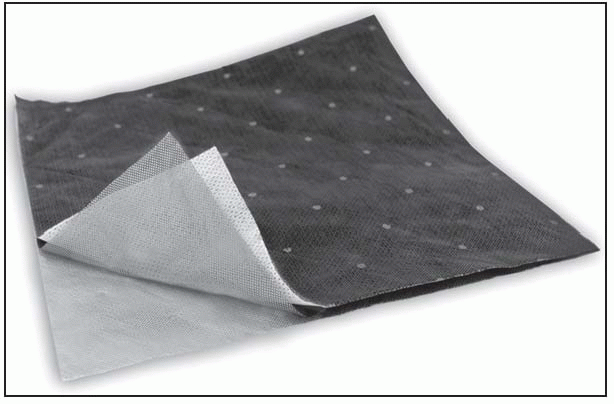 |
Not for use on patients with a sensitivity to silver
Not for use on patients during magnetic resonance imaging (MRI) examination
For external use only
Avoid contact with electrodes or conductive gels during electronic measurements, for example, EEG and ECG
Avoid exposure to temperatures above 50°C; protect from light
Not for use if product color isn’t uniform
Not for use if pack is opened or damaged
Follow standard protocol to cleanse wound; don’t use oil-based cleansing agents. Where required, wound cleansing should be performed according to local clinical protocol using sterile water only.
Remove the ACTICOAT 7 dressing from the package and cut to size.
Apply the dry ACTICOAT 7 dressing to the wound, either side down, as the exudate will be sufficient to activate the dressing.
Cover the ACTICOAT 7 dressing with an absorbent secondary dressing.
Complete the dressing with appropriate gauze wrappings if necessary.
Remove the ACTICOAT 7 dressing from the package and cut to shape.
Moisten the dressing with sterile water (don’t use saline).
Allow the dressing to drain on an absorbent surface in a sterile field for at least 2 minutes.
Apply the ACTICOAT 7 dressing to the wound surface, either side down.
Cover the dressing with a moist absorbent secondary dressing that may be prepared by saturating gauze with sterile water and wringing out the excess water.
Complete the dressing with appropriate gauze wrappings if necessary.
If the dressing dries and adheres to the wound, moisten or soak the dressing prior to removal.
Change the dressing depending on the amount of exudate present and the condition of the wound. Avoid using oil-based cleansing agents. The dressing may be worn for up to 7 days.
Remove the secondary dressing, and then remove ACTICOAT 7 from the wound bed. Make sure the dressing is moist before removing it.
Avoid forceful removal of the dressing and disruption of the healing wound.
Keep in mind that the dressing may cause transient discoloration.
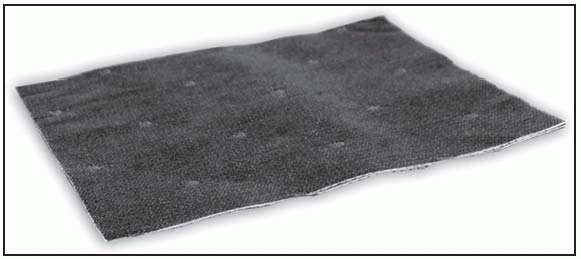 |
Not for use on patients with sensitivity to silver
Not for use on patients during magnetic resonance imaging (MRI) examination
For external use only
Avoid contact with electrodes or conductive gels during electronic measurements; for example, EEG and ECG
Not for exposure to temperatures above 50°C; protect from light
Not for use if product color isn’t uniform
Not for use if pack is opened or damaged
Follow standard protocol to cleanse wound; don’t use oil-based cleansing agents. Where required, wound cleansing should be performed according to local clinical protocol using sterile water only.
Remove the ACTICOAT 3 dressing from the package and cut to size.
Apply the dry ACTICOAT 3 dressing to the wound, either side down, as the exudate will be sufficient to activate the dressing.
Cover the ACTICOAT 3 dressing with an absorbent secondary dressing.
Complete the dressing with appropriate gauze wrappings if necessary.
Remove the ACTICOAT 3 dressing from the package and cut to shape.
Moisten the dressing with sterile water (don’t use saline).
Allow the dressing to drain on an absorbent surface in a sterile field for at least 2 minutes.
Apply the ACTICOAT 3 dressing to the wound surface, either side down.
Cover the dressing with a moist absorbent secondary dressing that may be prepared by saturating gauze with sterile water and wringing out the excess water.
Complete the dressing with appropriate gauze wrappings if necessary.
Change the dressing depending on the amount of exudate present and the condition of the wound. Avoid using oil-based cleansing agents. The dressing may be worn for up to 3 days.
Remove the secondary dressing, and then remove ACTICOAT 3 from the wound bed. Make sure the dressing is moist before removing it.
Avoid forceful removal of the dressing and disruption of the healing wound.
Keep in mind that the dressing may cause transient discoloration.
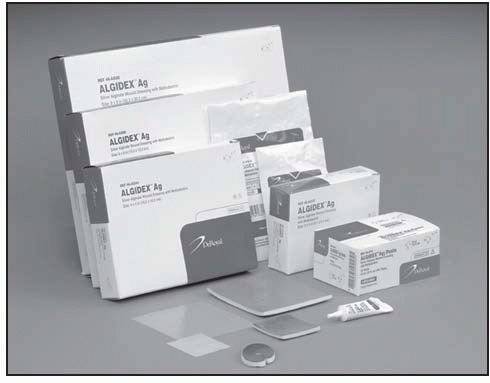 |
Foam Back: | 2″ × 2″, 4″ × 4″; A6209 |
4″ × 5″, 6″ × 6″; A6210 | |
8″ × 8″; A6211 | |
Thin Sheet: | 2″ × 2″, 4″ × 4″; A6196 |
4″ × 8″, 6″ × 6″; A6197 | |
8″ × 8″, 8″ × 16″, 16″ × 16″; A6198 | |
Paste: | 10 cc; A6261 |
Not for use on third-degree burns
Not for use on ulcers resulting from infections
Contraindicated for lesions associated with active vasculitis
Contraindicated for patients with sensitivity to alginates
Thoroughly cleanse wound with normal saline.
Apply Algidex Ag with silver matrix touching the wound.
Secure dressing in place with retention dressing such as gauze, transparent film, or tape.
Algidex Ag is antimicrobial for up to 7 days and may be worn until dressing has reached saturation.
Thoroughly cleanse wound with normal saline.
Remove backing from Algidex Ag Thin Sheet.
Place Algidex Ag Thin Sheet over shallow wounds, or pack into deep wounds.
Cover with appropriate secondary dressing based on wound drainage.
Algidex Ag Thin Sheet is antimicrobial for up to 7 days and may be worn until secondary dressing requires changing.
Thoroughly cleanse wound with normal saline.
Apply 114′ thickness of paste to shallow wounds, or completely fill deep wounds.
Cover with appropriate secondary dressing based on wound drainage.
Algidex Ag Paste is antimicrobial for up to 7 days and may be worn until secondary dressing requires changing.
Remove retention dressing, if applicable.
Gently lift Algidex Ag from the wound. If dressing adheres to wound, gently irrigate with saline to help loosen dressing.
Discard according to institutional policy.
Once dressing is removed, thoroughly cleanse wound with normal saline to remove any residue or debris from the wound.
Remove secondary dressing.
Gently irrigate wound with saline to help loosen Algidex Ag.
Continue to thoroughly cleanse wound to remove wound drainage or any residue left from Algidex Ag.
I.V. patch: | 3/4″ disc w/2 mm opening; A6209 |
1″ disc w/4 mm opening; A6209 | |
1″ disc w/7 mm opening; A6209 | |
1″ disc w/4 mm opening (with insert); A6209 | |
1 1/2″ disc w/7 mm opening; A6209 |
Not for use on third-degree burns
Contraindicated for patients with sensitivity to alginates
May be applied immediately following initial catheter placement or during routine catheter dressing change.
Apply Algidex Ag I.V. Patch with dark side touching the catheter and skin.
Secure patch in place with retention dressing such as gauze, transparent film, or tape.
Patch may be worn up to 7 days.
Remove retention dressing, if applicable.
Lift Algidex Ag I.V. Patch from the catheter and gently wipe any Algidex matrix residue during routine dressing change, using saline or antiseptic skin prep as stated in the institutional procedural guidelines.
Discard according to institutional policy.
Algidex Ag Packing Gauze: | 1/2″ × 5 yd; A6407 |
Algidex Ag Packing Gauze: | 1/4″ × 5 yd; A6407 |
Thoroughly cleanse wound with normal saline.
Remove appropriate amount of packing gauze from bottle.
Completely fill wound with packing gauze (lightly packing).
Cover with appropriate secondary dressing such as gauze, hydrocolloid, foam, or film dressing. Secondary dressing selection should be based on the amount of wound drainage.
Dressing may be worn up to 5 days or until cover dressing reaches saturation.
Remove secondary dressing.
Gently remove packing gauze.
Thoroughly cleanse wound to remove wound drainage or residue from Algidex Ag.
Reapply as necessary following directions above.
Not for use on third-degree burns
Contraindicated for patients with sensitivity to alginates
Clean the site according to institutional policy and procedures. Prepare and clean the skin surrounding the tracheostomy tube to remove excess moisture.
Remove the Algidex Ag Tracheostomy Dressing, locate the pre-cut opening and position it around the stoma or tracheostomy tube. Apply with the silver side (dark side) toward the patient.
If needed, the dressing may be cut to shape or size.
If additional fixation is required, transparent film dressings or tape may be used to help secure the dressing.
The tracheostomy site should be inspected frequently during the early stages of treatment to ensure skin integrity and clear airway. The dressing can be left in place undisturbed for up to 7 days, or until the foam pad becomes saturated with exudates.
Remove retention dressing, if applicable.
Lift the Algidex Ag Tracheostomy Dressing from around the tube and discard according to institutional policy.
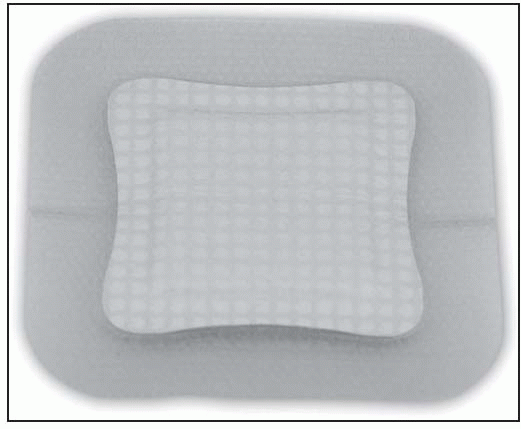 |
Non-Adhesive: | 4″ × 4″; A6209 |
6″ × 6″; A6210 | |
Adhesive: | 3″ × 3″; A6212 |
5″ × 5″; A6212 | |
Gentle: | 4″ × 4″; A6209 |
6″ × 6″; A6210 | |
Gentle Border: | 3″ × 3″; A6212 |
5″ × 5″; A6212 |
Not for use on patients known to be hypersensitive to silver sulfadiazine, silver or sulfonamides
Not for use on females who are at or near term pregnancy or lactating, on premature infants, or on newborn infants during the first months of life, as sulfonamides are known to cause kernicterus
Not for use with oxidizing agents such as hypochlorite solutions (e.g., Dakin’s) or hydrogen peroxide, as these can break down the absorbent hydrocellular component of the dressing
Select a dressing size that will cover the wound and leave approximately a 1/2” margin around the wound.
Cleanse the wound and the periwound skin with Dermal Wound Cleanser or normal saline.
Apply SKIN-PREP or NO-STING SKIN-PREP and allow it to dry.
Peel back the protector papers and anchor the dressing over the wound.
Smooth the dressing into place, ensuring that the edges of the dressing are not wrinkled.
Position dressing over the wound and secure it with tape or a bandage.
Cleanse the wound and surrounding skin with DERMAL Wound Cleanser or normal saline.
Prepare and cleanse the periwound area removing excess moisture. A skin protectant may not be necessary with the ALLEVYN Gentle dressings.
Select a dressing that allows at least a 1/2” margin onto the skin around the wound.
Remove the protector material from and apply the white, adherent side to the wound, ensuring good contact.
Secure ALLEVYN Gentle with a secondary dressing.
To remove, gently lift the dressing away from the wound.
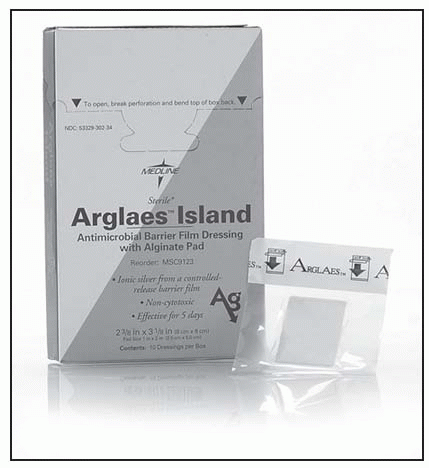 |
Film dressing: | 2 3/8″ × 3 1/8″ |
4″ × 4 3/4″ | |
3″ × 14″ (postop) | |
Film with Alginate pad: | 2 3/8″ × 3 1/8″ (1″ × 2″ pad) |
4″ × 4 3/4″ (2″ × 2″ pad) | |
4 3/4″ × 10″ (2 3/4″ × 8″ pad) |
Contraindicated for third-degree burns
Contraindicated in patients with hypersensitivity to silver
Clean the application site with normal saline solution or another appropriate cleanser, such as Skintegrity Wound Cleanser. Dry the surrounding skin to ensure it’s free from any greasy substance. Allow any skin preparation to dry completely.
Select an appropriate-sized dressing that allows 1 114′ to 1 112′ (3 to 4 cm) of attachment to healthy periwound skin.
With one hand, hold the dressing’s white tab with the printed side facing up. With the other hand, take hold of the loose film flap, and gently peel off the release sheet.
Hold the dressing on both ends, then turn it over so the adhesive surface is facing the wound. Ensure that both edges of the white tab are held together.
Apply the dressing, pressing firmly and smoothing down. Make sure the edges of the dressing are firmly fixed in place.
Take hold of the second release sheet at the end of the dressing opposite the white tab, and gently peel away and discard.
For moderately to heavily draining wounds, use the O-Technique. It involves cutting small openings into the dressing before removing the carrier sheet.
Excess drainage is allowed to pass through the dressing onto an absorbent secondary dressing. The technique is also helpful when using Arglaes under a compression dressing.
Gently lift up one corner of the dressing, and begin stretching it horizontally along the skin surface to break the adhesive bond.
When two sides of the dressing are partially removed, grasp both sides and stretch the dressing horizontally, parallel to the skin.
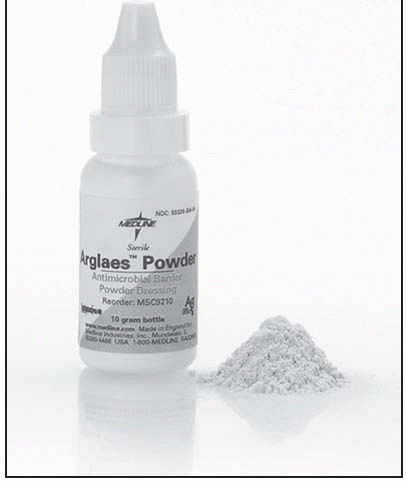 |
Not intended for surgical implantation
Not intended for use on third-degree burns
Not intended for use on patients with sensitivity to silver
Not for use with topical antibiotics or antiseptics
Clean the wound site with sterile saline or appropriate wound cleanser such as Skintegrity Wound Cleanser.
One 10-g bottle of Arglaes Powder is sufficient to dress a wound area of up to 4″ × 4″ (10 cm × 10 cm).
Gently dry the surrounding area.
Shake bottle thoroughly, then open Arglaes Powder by removing the tamperevident collar and screw cap.
Apply the dressing by squeezing the bottle (gently tap bottle if flow is blocked) and “puffing” the powder into the wound bed. Apply until wound surfaces are completely covered to a depth of not less than 1 mm.
Cover site with an appropriate secondary dressing. Heavily exuding wounds may require a more absorbent secondary dressing, such as Maxorb Alginate covered with a Stratasorb Composite Island Dressing.
Arglaes Powder should be changed when the secondary dressing is wet or if there is any sign of leakage. Heavily draining wounds may require more than one change per day. Dressing may remain in place up to 5 days.
To remove Arglaes Powder, gently lift and discard the secondary dressing. Irrigate the wound thoroughly with normal saline or appropriate wound cleanser, such as Skintegrity Wound Cleanser. Continue irrigating until all gelled or ungelled powder is removed.
Redress the wound as appropriate.
 |
Adhesive foam dressing: | 5″ × 5″; A6212 |
7″ × 7″; A6213 | |
Sacral dressing: | 9″ × 9″; A6213 |
Heel dressing: | 7 1/2″ × 8″; A6212 |
Non-Adhesive foam dressing: | 4″ × 4″; A6209 |
6″ × 6″; A6210 |
Contraindicated in patients with sensitivity to silver
Must be removed before radiation treatment or examinations that include X-rays, ultrasonic treatment, diathermy, or microwaves
Rinse the wound with physiologic saline or Sea-Clens Wound Cleanser. Gently dry the skin surrounding the wound.
Select a dressing that overlaps the wound edge by a minimum of 1′ (2.5 cm).
Remove the paper carrier from the dressing, center the dressing over the site, and apply to skin.
Use tape or appropriate secondary dressing to hold in place.
Dressing should be changed when clinically indicated or when visible signs of transparency approach 334′ (2 cm) from the edge of the dressing.
Dressing may be left in place for up to 7 days, depending on the condition of the wound.
Contraindicated for nonexuding and lightly exuding wounds
Not for use on third-degree burns
Contraindicated for those individuals with known sensitivity to silver and/or calcium alginate materials
Cleanse the wound with sterile water only! No saline or wound cleansers are to be used.
Pat dry surrounding area.
Apply dressing to the wound surface or, if the wound is deep and/or tunneled, gently and lightly pack the wound with the DermaGinate.
Cover with secondary absorbent dressing of choice.
Gently remove secondary dressing.
If fibers are sticking to wound base, irrigate with sterile water to loosen fibers, then lift the dressing.
Irrigate the wound liberally to ensure all fibers are removed.
Not for use on third-degree burns
Not for use on ulcers resulting from infections
Stay updated, free articles. Join our Telegram channel

Full access? Get Clinical Tree


